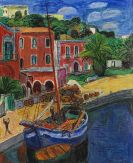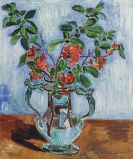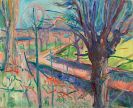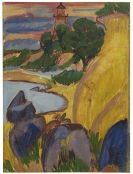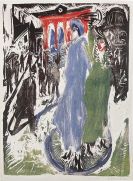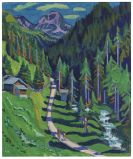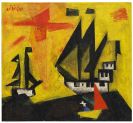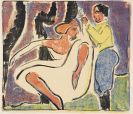
Hans Purrmann
Speyer
1880 -
Basel
1966
The artist and engraver Hans Purrmann was born on 10th April 1880 in Speyer. Between 1893-97 Purrmann worked as a decorative artist in his father’s workshop, and from 1897-1905, he studied at the Academy of Arts in Munich. His fellow students included Paul Klee and Vassily Kandinsky.
In winter 1904/05, Purrmann moved to Berlin and became a member of the Berliner Secession, on Max Liebermann’s recommendation. He regularly participated in exhibitions at the Secession. In November 1905, Purrmann moved to Paris, where he met "Fauves" such as Matisse (1869 – 1954) and Derain (1880 – 1954). He later undertook trips to various German cities with Matisse (1908, 1909/10 and 1910). His marriage to the artist Mathilde Vollmoeller (1876 – 1943) in January 1912 took him to Beilstein bei Heilbronn.
During the war, he lost his studio, apartment, and many of his works in Paris. From 1915 onwards, Purrmann participated in nearly all of the Free Secession exhibitions in Berlin, and occasionally the Berliner Secession exhibitions. In 1916, he moved permanently to Berlin. Between June and July 1918, Purrmann’s held his first large solo exhibition in art dealer Paul Cassirer’s gallery.
In March 1919, at Liebermann and Slevogt’s suggestion, the artist joined the Prussian Academy of Arts. Purrmann bought himself a fishing hut in Langenargen by the Bodensee. He stayed there regularly until 1935. He also undertook a number of trips to Sorrento, Ischia, Naples, Munich and Rome.
In 1925, he exhibited in the Galerie Pro Arte in Basel and Kaiserslautern. On his 50th birthday in April 1930, the press honoured Purrmann, and the German Ministry of the Interior presented him with an award. In November 1934, he made his last trip to Paris before the outbreak of World War Two, where he once more met Matisse. In 1933/34, the artist gave a number of pictures to Dr. Lucas Lichtenhan, the head of the Basel Kunsthalle on commission, in the hope that he might profit from the sale of his work. In October 1935 he moved to Italy and became head of the German artists’ foundation, Villa Romana.
Purrmann was branded a "degenerate artist" by the Nazis. In 1937, 36 of his paintings and a large number of his graphic works were removed from various museums. Two of Purrmann’s works were included in the "Degenerate Art" exhibition.
In early 1939, the chair of the Villa Romana foundation voted to sack Purrmann from his position, but this decision was withdrawn shortly afterwards. In March/April 1943, the artist had a solo exhibition in Florence. In the same year, his Berlin apartment was destroyed in an Allied bombing raid.
Purrmann fled Italy for Switzerland. In 1948, he was granted a work permit by the Swiss authorities. He moved to the Casa Camuzzi by Lugano lake. In 1950, he exhibited 64 pictures, 27 watercolours and 26 drawings in the Kunstmuseum Luzern. Purrmann also held a solo exhibition in the Pfalzgalerie in Kaiserslautern, which travelled to Speyer, Mannheim, Stuttgart, Munich, Hamburg, Bremen and Bochum. He participated in the first "documenta" in Kassel in 1955.
From April 1959, the artist lived in Villa Massimo in Rome. He fell seriously ill and became dependent on helpers and a wheelchair. On Purrmann’s 80th birthday, the Kunstverein Hannover staged the largest exhibition of his works to date, which included 168 of his paintings. In 1962, a retrospective exhibition of Hans Purrmann’s paintings toured Munich, Baden-Baden, and Frankfurt am Main. Purrmann spent the last months of his life, working on numerous portraits.
On 17th of April 1966, Purrmann died in a hospital in Basel, and was buried in Langenargen on 22nd April.
Would you like to sell a work by Hans Purrmann?
Infos for seller
